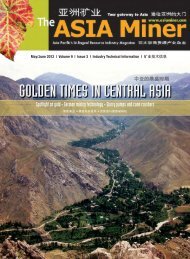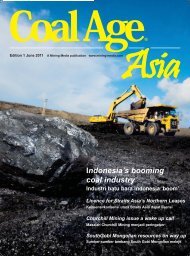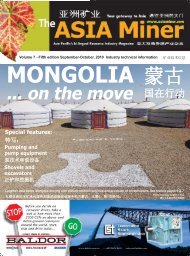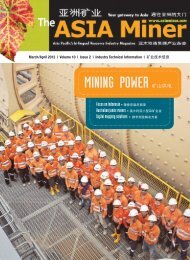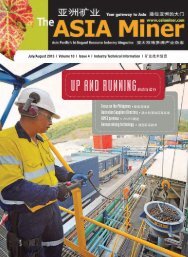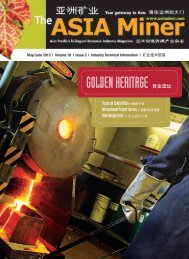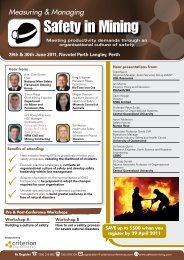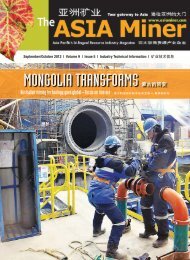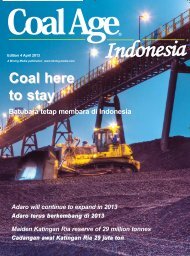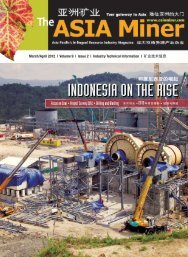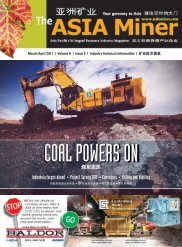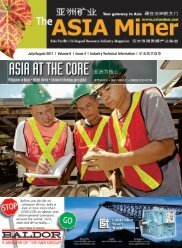Australia's junior explorers - The ASIA Miner
Australia's junior explorers - The ASIA Miner
Australia's junior explorers - The ASIA Miner
You also want an ePaper? Increase the reach of your titles
YUMPU automatically turns print PDFs into web optimized ePapers that Google loves.
Australian Junior Explorers<br />
CONSTRUCTION OF LUCKY BAY PORT UNDER WAY<br />
CONSTRUCTION of IronClad Mining’s Lucky<br />
Bay port facility is under way , after the company<br />
received approval from the South Australian<br />
government and finalized its detailed<br />
design. <strong>The</strong> project is a unique concept aimed<br />
at cutting road and rail transport distance from<br />
mine to port by about 350km.<br />
Significant works, including an 80 metr e<br />
channel extension, loading dock, and acoustic<br />
mounds and barriers, are required at the existing<br />
harbour. Initially, IronClad will freight its iron<br />
ore 156km by road to Lucky Bay then load it<br />
onto barges to take to vessels anchored offshore<br />
in the Spencer Gulf.<br />
IronClad will develop its floating port 10km<br />
offshore at Lucky Bay, to be serviced by two<br />
company-owned self propelled barges. Construction<br />
of the first of these barges in China is<br />
40% complete and the 57 metre-long vessel is<br />
expected to be finished by August. <strong>The</strong> port is<br />
expected to take three years to complete but<br />
will become a much closer alter native to the<br />
current option of Port Adelaide which is almost<br />
500km from the mine site. It’s expected the facility<br />
will open up a new multi-user shipping<br />
avenue for South Australian exporters.<br />
A recent capital injection of $12.1 million from<br />
the successful conversion of 16.2 million options<br />
as well as a $13 million investment fr om<br />
strategic share placements will be used to fund<br />
the construction costs. Part of the placement<br />
includes an offtake agreement with New Page<br />
Investments, which secures up to 50% of the<br />
iron ore produced from the Wilcherry Hill mine<br />
52 | <strong>ASIA</strong> <strong>Miner</strong> | July/August 2011<br />
for the first four years of production. New Page<br />
must also pay Ir onClad 95% of the agr eed<br />
value of the iron ore on each ship from the Luck<br />
Bay port within 30 days of its departure.<br />
Wilcherry Hill is 105km west of South Australia’s<br />
steel industry capital of Whyalla, and<br />
about 40km north of Kimba in the norther n<br />
Eyre Peninsula. It covers four tenements over<br />
an area of almost 1000sqkm. Access into the<br />
project area is via the Eyre Highway to Kimba<br />
and then graded service r oads and pastoral<br />
station tracks. IronClad produced its first ship-<br />
ment of iron ore from the Wilcherry Hill magnetite<br />
project in February this year, with a target of<br />
producing up to one million tonnes of premium<br />
grade direct shipping ore by January 2013. It<br />
also began construction of a dry magnetic separation<br />
(DMS) plant.<br />
Annual production is planned to ramp up rapidly<br />
at the pr oject, to become a 12 million<br />
tonne operation by 2015, when production will<br />
be shifted to the company’s nearby Hercules<br />
deposit which hosts a JORC inferred resource<br />
of 198 million tonnes.<br />
STROMBERG RARE EARTH RECOVERIES IMPROVE<br />
TUC Resources has incr eased heavy rar e<br />
earth element (HREE) recoveries by 10% at<br />
its flagship Str omberg prospect within the<br />
Daly project in the Northern Territory. Metallurgical<br />
test work results have confirmed recoveries<br />
of up to 85% from leach tests on the<br />
HREE rich clays found at the deposit.<br />
Two composite samples were tested and<br />
the 85% recovery was achieved using leaching<br />
by sulphuric acid after an initial caustic<br />
wash using sodium hydroxide.<br />
TUC’s managing director Ian Bamborough<br />
says work indicates that r ecovery from<br />
lower grade material is comparable to hig-<br />
A schematic of the gravity separation circuit proposed by IronClad Mining.<br />
her grade with a 0.2% to 0.4% total rar e<br />
earth oxide (TREO) composite giving a 77%<br />
recovery of total rare earth elements (TREE).<br />
“It appears that the caustic wash improves<br />
the amenability of the mineralized material<br />
to the leach process.”<br />
TUC says leaching of the HREE dir ectly<br />
into solution can result in a more direct processing<br />
route to an HREE intermediate/carbonate<br />
material, which would allow the<br />
company to generate mor e competitively<br />
valued product, when compared to other<br />
concentration methods.<br />
<strong>The</strong> leach tests also extracted up to 93% of<br />
uranium mineralization, possibly creating a secondary<br />
revenue stream for the project, whilst<br />
simultaneously serving to boost marketability<br />
and exportability of any futur e HREE product.<br />
<strong>The</strong> company says while these results are impressive,<br />
test work is still at an early stage.<br />
“To date 70% recovery of yttrium has been<br />
achieved with a respectable acid consumption<br />
of 371kg/tonne. Ef forts are now being<br />
made to improve the efficiency of the process<br />
including reducing reagent consumption by<br />
testing variation in leach times, acid to mineralized<br />
material mixes, and leach temperature,”<br />
says Ian Bamborough.



